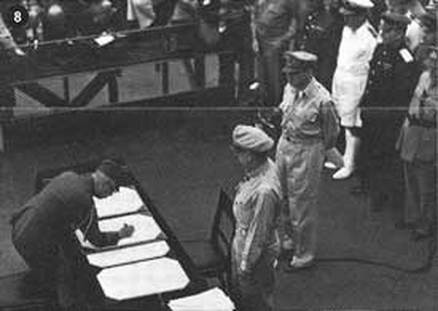Surrender of the Japanese Empire
“Having found the bomb, we have used it. We have used it against those who attacked us without warning at Pearl Harbor… We have used it in order to shorten the agony of war, in order to save thousands and thousands of Americans. We shall continue to use it until we completely destroy Japan’s capacity to make war. Only a Japanese surrender will stop us.”
-United States President Harry S. Truman
August 9, 1945
-United States President Harry S. Truman
August 9, 1945
By 1945 the Allies were steadily pushing their way towards Japan, but a full on victory was not yet in sight. After the successful victories of the United States and its Allies in both Okinawa and Iwo Jima the Japanese forces were weakened considerably, but still resisted domination and surrender at any and all costs. The United States worried about the number of lives they would have to lose to receive and unconditional surrender from Japan. Their concern and fear came about the by the disastrous blood shed seen in both Iwo Jima and Okinawa. The United States’ victory came at a high price, losing over 70,000 men in fighting. (Kapler, Randall, & Kelton, 1977) Japan lost more than double that amount, which made the allies wonder what they would do to defend their homeland. This was a scary thought for troops and commanders. The allies were focused on achieving a final victory with minimal cost of life, by using whatever strategy or means that was necessary. This is when the idea to use the atomic bomb on Japan came about. When President Truman was at the Potsdam Conference he was informed that the “ultimate weapon” might be ready for use. (“World War 2,” 2011) Truman suggested the idea to fellow allies, Winston Churchill of Great Britain and Joseph Stalin of Russia. No more was spoken of this while at conference. American military leaders were nearly unanimous in supporting the use of these weapons against Japan. They felt it would bring a swift and painless end to the drawn out war and no more young allied men would have to lose their lives for the cause. Others were very opposed to the idea of unleashing a “nuclear holocaust” on Japan and felt that victory could be attained in other ways. (“The Pacific Theater,” 2010) Debate over the use of the bomb went on from April to June of 1945. During this time a special commission to the president recommended the use of the atomic bomb against Japan. Many men who had worked on creating the bomb in the Manhattan Project gave fierce protests and warnings against the potential use of the bomb. Despite these warnings, Truman decided to go ahead with plans of dropping the atomic bomb on mainland Japan. On July 6, 1945 Allied leaders issued the Potsdam Declaration to the Japanese. This declaration defined the terms under which the war could be ended. The declaration called for unconditional surrender of all Japanese forces, as well as Allied occupation of Japan, and the dismantling of the Empire. (“The Pacific War,” 2003) As with many of the other battles between the Japanese and the allies, surrender was unacceptable. Japan did not accept the terms of the agreement. This ultimately led to the understanding that there would be no diplomatic solution to the war and Allied leaders continued to plan the final strike on Japan. On August 6, 1945 the first atomic bomb was dropped on Hiroshima, Japan. The bomb was equal to 20,000 tons of TNT and a mushroom cloud rose 40,000 feet in the air signifying complete devastation. It completely destroyed the city and killed over 80,000 people. (Hall, 1991) The dropping of the bomb named “Little Boy” marked the first time that an atomic weapon had ever been used in warfare; this directly ushered in the age of modern warfare. With such devastation, Japan still refused to surrender to Allied troops. Three days later, Major Charles Sweeny, took off from another runway on Tinian Island in the B-29 bomber named, Bockscar. This bomber was carrying another atomic bomb called, “Fat Man.” The intended target was again Hiroshima, but the Sweeny could not see anything for the massive clouds still surrounding the city. He turned west and headed for Nagasaki, Japan to drop the second bomb. (The Picture History, 1946) The casualties of this bomb were equally as devastating as the first, with the death toll reaching above 40,000 people. Not long after both of the bombs were dropped, President Truman came over the air announcing that the Allies had used the bombs to try to bring an end to the war. He said that they would continue to bomb Japan until they unconditionally surrendered. (Mayer, 1976) Just four days after the bombings, the Imperial Government sent a note to the Allies for a cease-fire. The United States responded by telling the Japanese that they must agree to the Potsdam Declaration. Emperor Hirohito announced the acceptance of an unconditional surrender to his people of August 15. Japan formerly surrendered to the Allies on September 2, 1945. (Mayer, 1976) The Japanese surrendered on board the USS Missouri, while 400 B-29’s circled overhead. This marked the significance of this historical event. The country had been devastated by the raids. It lay in ruins. The population of Tokyo alone was cut in half by the end of the war. Within weeks after the war had ended, both sides were cooperating to rebuild the country and reshape its foundation. (Mayer, 1976)

